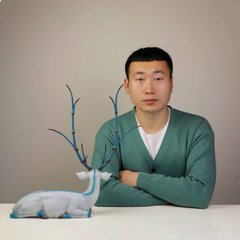Main Navigation
Artwork description:
⭕The shipping cost includes customs duties, so you don't need to worry about additional fees.(Including US shipments)
Since ancient times, the green bamboo, as a symbol of moral fortitude, has boasted the literary style of a Junzi (Confucian gentleman) characterized by humble-mindedness and upward-striving. It stands straight yet pliable, constantly reaching for the sky, its hollowness signifying an open heart eager to learn and progress. The white deer, like a celestial envoy descended from mythical realms, represents traditional auspiciousness. With its delicate form and gentle mien, its beauty is as ethereal and graceful as a fairy's dance, gliding through an idyllic landscape.
The artwork presents a blended entity of the contemplative deer and the vibrant green bamboo. Here, the deer seems to have found its tranquil sanctuary among the bamboos, their union more than a mere visual combination but a confluence of cultural essences. It aims to capture the auspicious omen of prosperity and good fortune ascending step by step, just like the climbing of the bamboo, and the life-cherished value of looking back on the past, as if the deer is reminiscing its old haunts. In this artistic portrayal, viewers are invited to sense the intertwined threads of hope for a prosperous future and the nostalgic longing for the roots that ground us, encapsulating the profound and nuanced spirit of the East.
Materials used:
bronze
Featured by our Editors:
Bamboo and Deer Reminiscence (2021) Bronze sculpture
by Zhang Youzhi 张有志
£1,711.72
- Bronze sculpture on Other
- From a limited edition of 8
- Size: 40 x 45 x 20cm
- Signed and numbered certificate of authenticity
- Style: Expressive and gestural
- Subject: Animals and birds
Loading
Artwork description
⭕The shipping cost includes customs duties, so you don't need to worry about additional fees.(Including US shipments)
Since ancient times, the green bamboo, as a symbol of moral fortitude, has boasted the literary style of a Junzi (Confucian gentleman) characterized by humble-mindedness and upward-striving. It stands straight yet pliable, constantly reaching for the sky, its hollowness signifying an open heart eager to learn and progress. The white deer, like a celestial envoy descended from mythical realms, represents traditional auspiciousness. With its delicate form and gentle mien, its beauty is as ethereal and graceful as a fairy's dance, gliding through an idyllic landscape.
The artwork presents a blended entity of the contemplative deer and the vibrant green bamboo. Here, the deer seems to have found its tranquil sanctuary among the bamboos, their union more than a mere visual combination but a confluence of cultural essences. It aims to capture the auspicious omen of prosperity and good fortune ascending step by step, just like the climbing of the bamboo, and the life-cherished value of looking back on the past, as if the deer is reminiscing its old haunts. In this artistic portrayal, viewers are invited to sense the intertwined threads of hope for a prosperous future and the nostalgic longing for the roots that ground us, encapsulating the profound and nuanced spirit of the East.
Materials used:
bronze
Featured by our Editors:
14 day money back guaranteeLearn more




